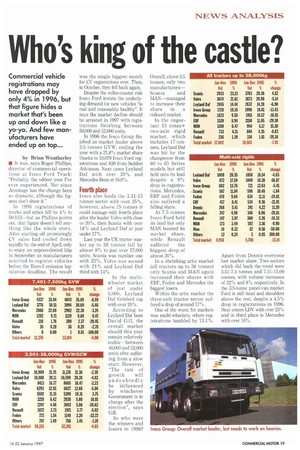Who's king of the castle?
Page 21

If you've noticed an error in this article please click here to report it so we can fix it.
Commercial vehicle registrations may have dropped by only 4% in 1996, but that figure hides a market that's been up and down like a yo-yo. And few manufacturers have ended up on top...
by Brian Weatherley • It was, says Roger Phillips, director of commercial operations at Iveco Ford Truck: "Probably the oddest year I've ever experienced. Not since Armitage has the change been so dramatic, although the figures don't show it."
In 1996 registrations of trucks and artics fell by 4% to 50,153-but as Phillips points out, that figure doesn't tell anything like the whole story. After starting off promisingly CV sales had cooled down rapidly by the end of April, only to enjoy an unprecedented blip in September as manufacturers scurried to register vehicles before the Euro-2 emission legislation deadline. The result was the single biggest month for CV registrations ever. Then, in October, they fell back again.
Despite the roller-coaster ride Iveco Ford insists the underlying demand for new vehicles Is real and reasonably healthy". It says the market decline should be arrested in 1997 with registrations finishing between 50,000 and 52,000 units.
In 1996 the Iveco Group finished as market leader above 3.5 tonnes GVW, ending the year with a 21.8% market share thanks to 10,070 Iveco Ford registrations and 839 from Seddon Atkinson. Next came Leyland Daf with over 20% and Mercedes-Benz at 16.8%.
Fourth place
Iveco also leads the 3.51-15 tonnes sector with over 35%, however, above 15 tonnes it could manage only fourth place after the leader Volvo with close to 20%, then Scania with over 18% and Leyland Daf at just under 17%.
Last year the UK tractor market up to 38 tonnes fell by almost 8% to just over 17,000 units. Scania was number one with 23%, Volvo was second with 21% and Leyland Daf third with 14%.
In the multiwheeler market of just under 5,000, Leyland Daf finished top with over 20%.
According to Leyland Dal boss David Gill, the overall market should this year remain relatively stable-between 46,000 and 52,000 units after suffering from a slow start. However, "The rate of growth will undoubtedly be influenced by whichever Government is in charge after the election", says Gill.
So who were the winners and losers in 1996?
Overall, above 3.5 tonnes, only two manufacturers
Scania and MAN-managed to increase their share in a reduced market.
In the important 15 tonne+ two-axle rigid market, which includes 17-tonners, Leyland Daf was hit by the changeover from 60 to 65 Series models but still held onto its lead despite a 9% drop in registrations. Mercedes, ERF and Foden also suffered a falling share.
At 7.5 tonnes Iveco Ford held its lead but only MAN boosted its market share, while Renault
suffered the biggest drop of almost 30%.
In a shrinking artic market (all tractors up to 38 tonnes) only Scania and MAN again increased their shares with ERF, Foden and Mercedes the biggest losers.
Within the artic market the three-axle tractor sector suffered a drop of around 17%.
One of the worst hit markets was multi-wheelers, where registrations tumbled by 13.1%. Apart from Dennis everyone lost market share. Two sectors which did buck the trend were 3.51-7.4 tonnes and 7.51-15.00 tonnes, with volume increases of 22% and 8% respectively. In the 3.5-tonne panel-van market Ford is still head and shoulders above the rest, despite a 4.5% drop in registrations in 1996. Next comes LDV with over 23% and in third place is Mercedes with over 16%.












































































































